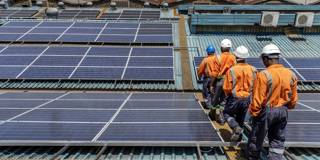While some low- and lower-middle-income countries have regained access to financial markets, liquidity pressures have continued to increase. Immediate debt relief remains the best way to stabilize developing economies and enable them to pursue climate-related investments.
PARIS/BASEL – For the first time in two years, some low-income and lower-middle-income countries (LMICs) can access the bond market. But many others remain still in dire need of liquidity and face punishing interest rates. Amid this ongoing crisis, the Finance for Development Lab’s proposal for a “liquidity bridge” that would enable developing economies to extend the maturity of their debts by 5-10 years and allocate resources toward climate mitigation and adaptation remains as necessary as ever.

PARIS/BASEL – For the first time in two years, some low-income and lower-middle-income countries (LMICs) can access the bond market. But many others remain still in dire need of liquidity and face punishing interest rates. Amid this ongoing crisis, the Finance for Development Lab’s proposal for a “liquidity bridge” that would enable developing economies to extend the maturity of their debts by 5-10 years and allocate resources toward climate mitigation and adaptation remains as necessary as ever.